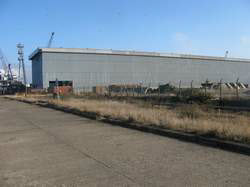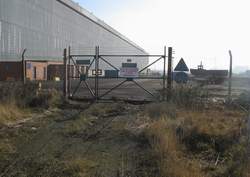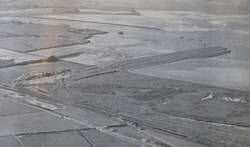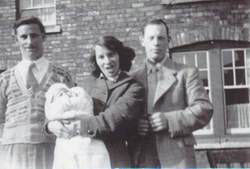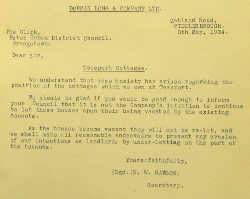Abandoned Communities ..... Teesport
Some memories of life at Teesport in the 1920s and early 1930s have come to me from Naomi Broadfoot, formerly Naomi Jones, mentioned on the previous page as eight years old in 1930. Children over eight had to walk about three miles to get to school in Grangetown. Naomi would complete the journey regardless of the weather, sometimes managing to get to school when pupils living in Grangetown itself failed to make it.
According to Naomi Broadfoot, Ronald Buchan, otherwise known as Mr Boocan, had some kind of administrative position at Teesport. As the Buchans were the only family still living in Teesport in 1938 and 1939 it seems likely that Ronald Buchan continued to serve as general caretaker after everyone else had left.
Naomi recalls that the the shop in Teesport was run by Eleanor and Michael Hollywood, who lived at number 33. By 1936 the shop had been taken over by John and Elizabeth Simms. There was a communal area, possibly the mission room, where men would meet, smoke, and play cards. In the early 1930s employment was scarce, but at least one man made a living by fishing for salmon in the Tees. A popular game among the children involved broken pieces of pottery, any pieces with gold in the pattern having a higher value in the game.
Please let me know if you think you may know the name and rules of this game.
When Cyril Fisk went to take a service at Teesport on 7 October 1934 Jim Wilkinson went with him to play the organ. I assume the service was held in the mission room. My father was told that the houses were all condemned. The congregation included about 20 dirty children and a woman whose teeth smelled worse than a thousand sewers. Cyril Fisk found the service a "very difficult job".
One of the 20 dirty children may have been Cliff Edwards, who always had string in his shoes and no socks. Cliff Edwards, looking a lot smarter, appears in a photograph taken around 1950, reproduced on the left.
The only incident I know about at Teesport was an outbreak of scarlet fever. The minutes of a meeting of Eston UDC on 27 September 1933 record that a petition had been received from the residents of Teesport requesting that action be taken regarding the outbreak. The petition had been conveyed to the council by Councillor Catchpole. Subsequently there are entries referring to this petition in the minutes of the Sanitation Committee, the last on 1 March 1934, but there is no evidence that any action was taken. By that date the disease may have passed. Scarlet fever may have come into Teesport from neighbouring suburbs, but it is also possible that it arrived by sea. In his 1934 Annual Report the Medical Officer of the River Tees Port Sanitary Authority reported that three cases of Scarlet Fever had been detected on incoming ships, one on a coastal vessel and two on a boat from Norwich.
People moved away from Teesport over a period of several years. The process had certainly begun by 1934. By that date Bolckow Vaughan had ceased to exist, and the land occupied by the houses was owned by two companies, as you may just be able to make out on the map at the foot of page 1. The part of Teesport closer to the river was owned by Swan, Hunter & Wigham Richardson, the southern part by Dorman Long. In May 1934 both companies wrote to Eston UDC to assure the council they intended to allow the houses to become vacant. They promised that as tenants departed the houses would not be re-let, and they would make sure that no sub-letting occurred. It is not clear whether this decision was initiated by the companies or whether they were asked to take this action by the council.
I have seen just one photograph of the buildings at Teesport. It is reproduced on the left. It appears that the buildings on the land owned by Dorman Long had already been demolished when that photograph was taken in 1947, but the buildings nearer to the river can be made out in the distance. A view from the same angle today would be dominated by the Tees Dock. There are now plans to build a biomass power station in the area around Teesport.
I visited Teesport in February 2013. I went with two members of the Cleveland and Teesside Local History Society, Val Harrison and Allan Wilby. We went first to the Harbour Master's offices, where we had the pleasure of meeting the Harbour Master, Jerry Drewitt, and the Chief of the Harbour Police, Denis Murphy. Then we put on hard hats and yellow jackets, and walked a short distance along the river bank to the location of Teesport. We were unable to tell exactly where the buildings would have been. Archaeologists might have spotted more than us, but we saw no indication that over a hundred people once lived here.
According to Naomi Broadfoot, Ronald Buchan, otherwise known as Mr Boocan, had some kind of administrative position at Teesport. As the Buchans were the only family still living in Teesport in 1938 and 1939 it seems likely that Ronald Buchan continued to serve as general caretaker after everyone else had left.
Naomi recalls that the the shop in Teesport was run by Eleanor and Michael Hollywood, who lived at number 33. By 1936 the shop had been taken over by John and Elizabeth Simms. There was a communal area, possibly the mission room, where men would meet, smoke, and play cards. In the early 1930s employment was scarce, but at least one man made a living by fishing for salmon in the Tees. A popular game among the children involved broken pieces of pottery, any pieces with gold in the pattern having a higher value in the game.
Please let me know if you think you may know the name and rules of this game.
When Cyril Fisk went to take a service at Teesport on 7 October 1934 Jim Wilkinson went with him to play the organ. I assume the service was held in the mission room. My father was told that the houses were all condemned. The congregation included about 20 dirty children and a woman whose teeth smelled worse than a thousand sewers. Cyril Fisk found the service a "very difficult job".
One of the 20 dirty children may have been Cliff Edwards, who always had string in his shoes and no socks. Cliff Edwards, looking a lot smarter, appears in a photograph taken around 1950, reproduced on the left.
The only incident I know about at Teesport was an outbreak of scarlet fever. The minutes of a meeting of Eston UDC on 27 September 1933 record that a petition had been received from the residents of Teesport requesting that action be taken regarding the outbreak. The petition had been conveyed to the council by Councillor Catchpole. Subsequently there are entries referring to this petition in the minutes of the Sanitation Committee, the last on 1 March 1934, but there is no evidence that any action was taken. By that date the disease may have passed. Scarlet fever may have come into Teesport from neighbouring suburbs, but it is also possible that it arrived by sea. In his 1934 Annual Report the Medical Officer of the River Tees Port Sanitary Authority reported that three cases of Scarlet Fever had been detected on incoming ships, one on a coastal vessel and two on a boat from Norwich.
People moved away from Teesport over a period of several years. The process had certainly begun by 1934. By that date Bolckow Vaughan had ceased to exist, and the land occupied by the houses was owned by two companies, as you may just be able to make out on the map at the foot of page 1. The part of Teesport closer to the river was owned by Swan, Hunter & Wigham Richardson, the southern part by Dorman Long. In May 1934 both companies wrote to Eston UDC to assure the council they intended to allow the houses to become vacant. They promised that as tenants departed the houses would not be re-
I have seen just one photograph of the buildings at Teesport. It is reproduced on the left. It appears that the buildings on the land owned by Dorman Long had already been demolished when that photograph was taken in 1947, but the buildings nearer to the river can be made out in the distance. A view from the same angle today would be dominated by the Tees Dock. There are now plans to build a biomass power station in the area around Teesport.
I visited Teesport in February 2013. I went with two members of the Cleveland and Teesside Local History Society, Val Harrison and Allan Wilby. We went first to the Harbour Master's offices, where we had the pleasure of meeting the Harbour Master, Jerry Drewitt, and the Chief of the Harbour Police, Denis Murphy. Then we put on hard hats and yellow jackets, and walked a short distance along the river bank to the location of Teesport. We were unable to tell exactly where the buildings would have been. Archaeologists might have spotted more than us, but we saw no indication that over a hundred people once lived here.
Three
Teesport in February 2013
Another view
The Tees estuary in 1947, seen from the east
Letter from Dorman Long to Eston Urban District Council
The Jones family in 1952, by which time they were living in Vaughan Street, Grangetown.
Sarah in the centre, Percy on her left, and Naomi on her right.
Cliff Edwards (in front of the window), with his wife and first child
